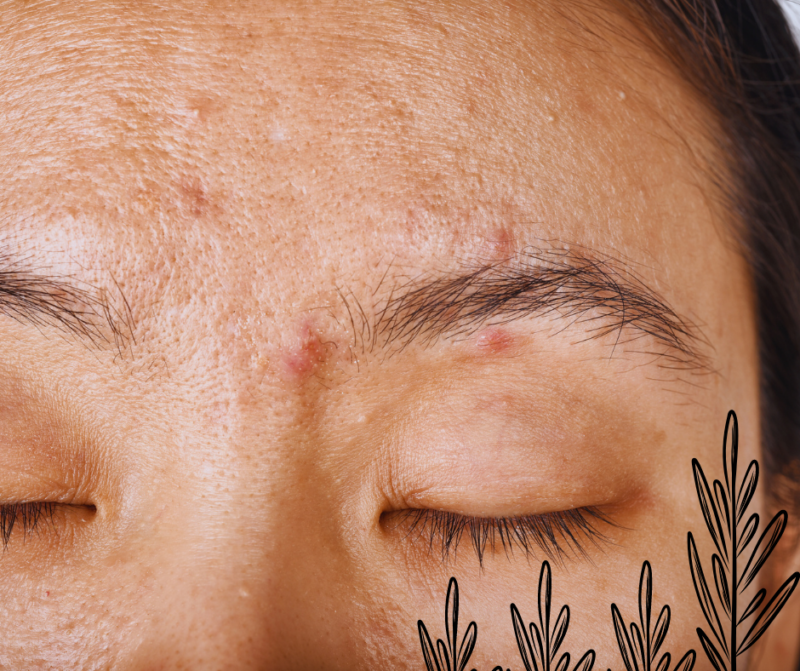
Share Post:
Can you imagine waking up each morning with clear, smooth skin? Sounds amazing, right? But for many of us, the reality is a bit different. Clogged pores—ugh, they can really mess with the glowing complexion we all want.
Pores are an inevitable part of our skin’s landscape, but when they become clogged, they can lead to a host of skin problems that can feel frustrating and stubborn.
But here’s the good news: there’s a way to tackle them head-on. Whether you’re dealing with blackheads, whiteheads, or those deeper, more annoying breakouts, getting a handle on clogged pores is the first step toward achieving that dream skin.!
What Exactly Are Clogged Pores?
Clogged pores, also known as closed comedones, occur when oil (sebum) and dead skin cells accumulate in your pores, causing blockages. These blockages can manifest as whiteheads or blackheads, and if left untreated, can lead to more severe skin issues like acne or cysts.
Unlike inflamed acne, clogged pores don’t always cause redness or swelling. Instead, they appear as small, flesh-colored bumps on the skin. Because they don’t inflame like typical pimples, they can persist for weeks, months, or even longer if not properly addressed. Several factors can contribute to clogged pores, including:
- Excess Sebum Production: Your skin naturally produces oil, but an overproduction can lead to clogged pores.
- Dead Skin Cells: If dead skin cells aren’t properly sloughed away, they can mix with oil and clog your pores.
- Product Build-Up: Using heavy or pore-clogging skincare and makeup products can exacerbate the problem.
- Hormonal Changes: Hormonal fluctuations, particularly during puberty, menstruation, or pregnancy, can increase sebum production.
- Diet and Lifestyle: Poor diet, stress, and lack of sleep can also affect your skin’s health, leading to clogged pores.
Specific Skin Problems and Their Solutions
Different types of clogged pores require different treatments. Let’s break down some common skin concerns and how to address them.
1. Indented Scarring from Previous Breakouts
Deep, cystic, or nodular breakouts can cause indented scars, as they damage the skin’s collagen and elastin fibers. To improve skin texture, use a vitamin C serum and prescription retinoids, which help boost collagen production.
2. Enlarged Pore from Piercing
Piercings can result in permanently enlarged pores, especially in delicate areas. Options for treating enlarged pores from piercings are limited. You might consider using fillers to smooth the area or avoid using heavy makeup, which can make the pores appear more pronounced.
3. Enlarged Pores in the Crevice of the Chin
Enlarged pores in this area can be particularly noticeable when the lip is pulled taut. Regular cleansing and the use of a gentle toner can help maintain cleanliness and minimize the appearance of these pores.
Avoid stretching the skin unnecessarily, as this can make the pores more prominent.
4. Blemish (Papule)
A clogged pore can lead to a papule, which is an inflamed bump that might develop into a pustule. Use a non-drying spot treatment specifically for papules. Once the papule matures into a pustule, it can be gently extracted. If needed, apply a drying spot treatment to speed up the healing process.
5. Post-Breakout Marks
Discoloration from previous breakouts can leave lingering marks on the skin. Incorporate regular exfoliation into your skincare routine and always wear sunscreen to help fade these marks. Prevent future breakouts to avoid new discoloration.
6. Clogged Pores (Closed Comedones)
These are white, non-inflamed bumps caused by congested skin. Keep your skin clean by cleansing thoroughly and exfoliating regularly. Use both chemical exfoliants, like salicylic acid or glycolic acid, and physical exfoliants. Hydrate your skin with water-based products, avoiding those that are overly drying.
7. Blackheads
Blackheads are open comedones where trapped sebum and debris oxidize and turn black. Regular exfoliation and professional extraction are key to managing blackheads. If you choose to extract at home, ensure you use proper techniques to avoid damaging your skin.
8. Milia
Milia are small, round white bumps caused by trapped keratin under the skin. They should be removed by a professional to prevent skin damage.
They are often caused by the use of overly greasy products or can be due to genetics, so adjust your skincare routine accordingly.
9. Dehydration
Dehydrated skin can appear dry, flaky, and more prone to clogged pores due to the buildup of dead skin cells. Use a moisturizer suited for your skin type and avoid products that are too harsh or drying. Ensure you’re hydrating adequately, both topically and by drinking plenty of water.
10. Cystic Breakouts
Cystic breakouts are deep, painful, and often occur on the jawline. Avoid picking at cystic acne, as this can worsen the condition. Use non-drying treatments like sulfur-based masks, and consider reducing dairy intake, as it can sometimes trigger cystic acne in susceptible individuals.
11. Inflammation (Redness)
Redness and poor circulation may indicate underlying inflammation in the skin. Improve circulation through gentle facial massage or head-down exercises.
12. Skin Growths (Sebaceous Hyperplasia)
Sebaceous hyperplasia are benign skin growths that can be mistaken for clogged pores. These growths need to be removed by a dermatologist, typically through methods like electric cauterization or cryotherapy.
How to Prevent Clogged Pores
Preventing clogged pores is all about maintaining a consistent and effective skincare routine. Here are some essential tips:
Cleanse Regularly
Cleansing is the cornerstone of any skincare routine, particularly when it comes to preventing clogged pores. Use a gentle, sulfate-free cleanser that suits your skin type. Double cleansing in the evening can be particularly effective for removing makeup, sunscreen, and impurities that accumulate throughout the day.
Exfoliate Wisely
Exfoliation helps remove dead skin cells, which can contribute to clogged pores. Incorporate both chemical exfoliants (like AHAs and BHAs) and physical exfoliants (like scrubs) into your routine. However, avoid over-exfoliating, as this can irritate the skin and lead to more clogging.
Hydrate, Hydrate, Hydrate
Keeping your skin well-hydrated is crucial in preventing clogged pores. Opt for water-based moisturizers that won’t clog your pores. If you have oily skin, look for non-comedogenic products that provide moisture without adding excess oil.
Be Mindful of Your Products
Certain skincare and makeup products can contribute to clogged pores. Always choose non-comedogenic products and be cautious with heavy, greasy creams and foundations.
Sun Protection
Sunscreen is a must in any skincare routine. Not only does it protect your skin from harmful UV rays, but it also prevents hyperpigmentation and post-breakout marks from worsening. Choose a sunscreen that suits your skin type and is non-comedogenic.
Professional Treatments
For persistent clogged pores, consider seeking professional help. Chemical peels, microdermabrasion, and laser treatments can all help reduce the appearance of clogged pores and improve overall skin texture.
Lifestyle Matters
Remember that what you put into your body can affect your skin. A balanced diet, regular exercise, and adequate sleep can all contribute to clearer, healthier skin.
Patience and Consistency Are Key
Clearing clogged pores isn’t an overnight process. It requires patience, consistency, and often a bit of trial and error. Here’s a step-by-step approach to help you along the way:
- Start with a Solid Routine: Build a skincare routine that includes cleansing, exfoliating, moisturizing, and protecting your skin from the sun.
- Monitor Your Skin’s Response: Pay attention to how your skin reacts to different products. If something isn’t working, don’t be afraid to adjust your routine.
- Avoid Harsh Treatments: While it might be tempting to go for the strongest products, this can often backfire. Gentle, consistent care is more effective in the long run.
- Seek Professional Advice: If your clogged pores persist despite your best efforts, don’t hesitate to consult a dermatologist. They can provide personalized recommendations and treatments that over-the-counter products can’t offer.
Wrapping It Up
Your skin didn’t get clogged overnight, and it won’t clear up overnight either. But with time, care, and possibly some professional help, you can say goodbye to clogged pores for good.
Related Posts:












